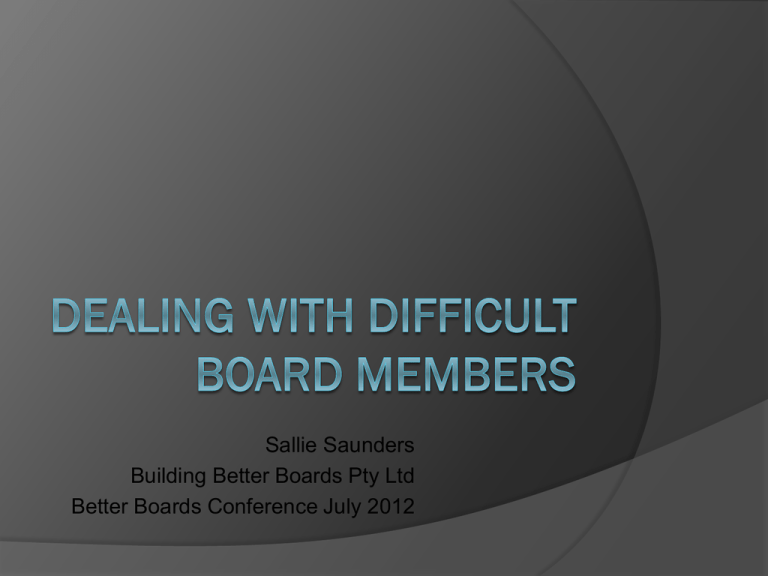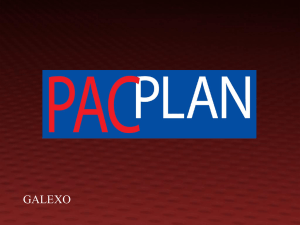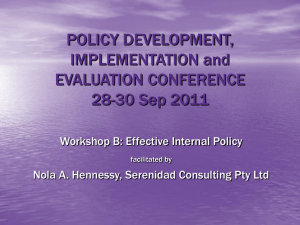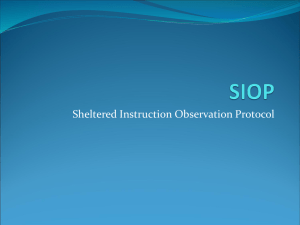Dealing With Difficult Board Members
advertisement

Sallie Saunders Building Better Boards Pty Ltd Better Boards Conference July 2012 Where’s the problem? Difficult board member or ‘healthy dissenter’? or Is the whole board in trouble? July 2012 Sallie Saunders, Building Better Boards Pty Ltd Difficult board member or ‘healthy dissenter’? Has the board lost focus? Are meetings badly run? Are Board agendas poorly developed and/or not followed? Is the Board culture closed or open? Is the trouble maker really a ‘healthy dissenter’ trying to refocus the board? July 2012 Sallie Saunders, Building Better Boards Pty Ltd Boards in trouble Create negativity and disagreement Can be dominated by cliques and factions Take problems outside the boardroom Clash with staff and stakeholders Need expert help to work through the trouble July 2012 Sallie Saunders, Building Better Boards Pty Ltd Difficult board members Can disrupt the work of the board Promote conflict May have personal agendas, behaviours or conflicts of interest that prevent them from being effective board members July 2012 Sallie Saunders, Building Better Boards Pty Ltd Grin and bear it? “Fearing the pain involved, almost all of us, to a greater or lesser degree, attempt to avoid problems. We procrastinate, hoping that they will go away… We attempt to skirt around problems rather than meet them head on.” M. Scott Peck, The Road Less Traveled July 2012 Sallie Saunders, Building Better Boards Pty Ltd The case for action Difficult board members can eclipse the talents of other board members stifle fresh contributions undermine efforts to recruit new people frustrate valuable staff members block healthy growth waste valuable resources of time and talent July 2012 Sallie Saunders, Building Better Boards Pty Ltd Who should act? The responsibility for the board’s effective work – both governance and support – is the responsibility of the Executive Director [CEO] Peter Drucker Sometimes a board will “follow” a strong staff. Sometimes it will lead the organization. Ideally it will demonstrate flexibility in continually redefining its partnership with management…Executive Directors Guide, Third Sector New England, Boston MA July 2012 Sallie Saunders, Building Better Boards Pty Ltd Managing trouble Requires: the combined efforts of all board members - not just the chairperson Courage and conviction Skill development July 2012 Sallie Saunders, Building Better Boards Pty Ltd Focus on behaviour beware labelling and isolating “the one with the problem” from “normal us” focus on difficult behaviour and try for face-saving solutions deal with the negative consequences of behaviour rather than condemn the individuals who display it July 2012 Sallie Saunders, Building Better Boards Pty Ltd Some troublesome behaviours Board member is regularly absent, arrives late or is unprepared Board member confuses roles and responsibilities with those of the CEO Board member discloses confidential information and/or criticizes the organisation in public Board member bullies or displays a controlling personality July 2012 Sallie Saunders, Building Better Boards Pty Ltd Some strategies for change Develop position descriptions for board members and keep boundaries clear Develop effective feedback skills Be prepared to speak up about what the problem is, why and what you would like to change Call in an expert Check the legal issues Stay July 2012 calm and carry on! Sallie Saunders, Building Better Boards Pty Ltd Help the board to change Reserve board meetings for work that has meaning -use a consent agenda Communicate efficiently – short sharp reports Use IT systems well Help the Chair establish rules for discussion so that ‘time vampires’ are controlled Clarify perceptions & positions so that robust debate generates options rather than road blocks Research learning opportunities for the board July 2012 Sallie Saunders, Building Better Boards Pty Ltd Preventative strategies Carefully recruit new board members with: Humility and self-awareness A sense of humour An ability to see the big picture and think strategically Emotional maturity Good communication skills A learning orientation to board work Provide a trial period and set term limits Form a board development committee Develop a Board Code of Conduct and enforce it Establish a termination process Incorporate conflict resolution and consensusbuilding strategies July 2012 Sallie Saunders, Building Better Boards Pty Ltd Parting ways A process not an ambush A choice Handled best by peers A group process Not the end of relationships A loss Requires discussion and time to adjust July 2012 Sallie Saunders, Building Better Boards Pty Ltd








